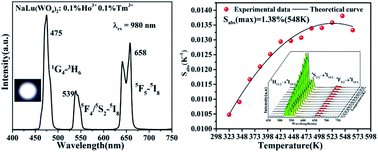White light tuning and temperature sensing of NaLu(WO4)2:Ln3+ up-converting phosphor
Abstract
NaLu(WO4)2:Ln3+ phosphors were synthesized via a hydrothermal method combined with subsequent calcination. Under excitation at 980 nm, 25%Yb3+, 0.5%Tm3+ and 25%Yb3+, 1%Ho3+-doped phosphors produce blue, green and red emissions. Namely, NaLu(WO4)2:25%Yb3+, 0.1%Ho3+, 0.1%Tm3+ nanocrystals show suitable intensities of blue, green, and red (RGB) emission, resulting in the production of perfect and bright white light with CIE-x = 0.3299 and CIE-y = 0.3293, which is very close to the standard equal energy white light illumination (x = 0.33, y = 0.33). Based on FIR theory, the temperature dependence of NaLu(WO4)2:20%Yb3+, 1%Er3+ was studied, and the maximum value of sensitivity was obtained as 1.38% K−1 at 543 K, which is better than that of previously reported temperature-sensing materials. It proves that the NaLu(WO4)2:Ln3+ phosphors have potential applications in white lighting, optical temperature measurement and other fields.



 Please wait while we load your content...
Please wait while we load your content...